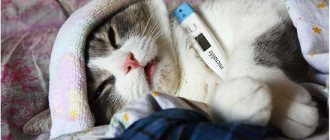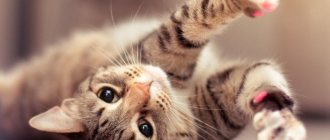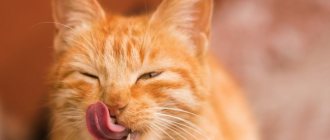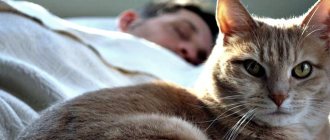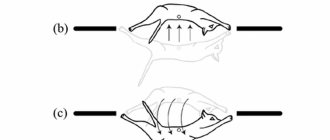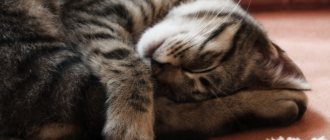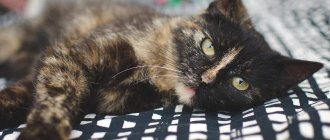Woman.ru experts
Find out the opinion of an expert on your topic
Muratova Anna Eduardovna
Psychologist, Online consultant. Specialist from the site b17.ru
Natalya Maratovna Rozhnova
Psychologist. Specialist from the site b17.ru
Yana Vyacheslavovna Rom
Psychologist, Family consultant. Specialist from the site b17.ru
Pivneva Natalya Sergeevna
Psychologist. Specialist from the site b17.ru
Ekaterina Strazhenskikh
Psychologist. Specialist from the site b17.ru
Tankova Oksana Vladimirovna
Psychologist, Online consultant. Specialist from the site b17.ru
Korotina Svetlana Yurievna
Psychotherapist. Specialist from the site b17.ru
Senetskaya Tatyana Mikhailovna
Psychologist. Specialist from the site b17.ru
Taras Solonin
Psychologist. Specialist from the site b17.ru
Elena Barkhatova
Psychologist, Consultant. Specialist from the site b17.ru
my cat doesn't mind being touched. but. depends on the mood. He won’t let you just come up and grab him by the paws. and if it’s lying around, then you can stroke it by the paws and between the claws, only gently.
But mine love... They don’t like it when I tickle their nostrils with my mustache))) They sneeze and snort. And my beloved cat puts up with everything from me. Now she is 53 days pregnant, I kiss her belly so much, oh how she loves it! She rolls over on her back and purrs))
Mine lets me touch everything, but not everyone, just me. She tries to bite or scratch her husband.
And my cat really doesn’t like it when I kiss him. He only climbs into his husband’s arms, but loves when people look at him, praise him and admire his beauty.
, well, for daddy’s last question, I could send him a photo of a Kurilian bobtail.
Related topics
Cats are animals with character) It’s not that they don’t like to be touched - they just don’t like to “feel like toys.” If they come up and want affection -> you can touch me for anything :)) (At least mine are like that..) (I’m thinking - but I also can’t stand it when people touch me on the neck - it doesn’t matter who and with what purpose. I wonder why? :D)
I have a strange cat. He gets such a thrill when you massage his paws, between the boys, the pads. He spreads them out and purrs like crazy :))))))
And my cat loves it! He stretches out his paw - his left one, since I always massage his paw with my right hand. The husband laughs that the cat is showing “Heil Hitler”.
My cat also loves it when I touch between his toes, he also purrs, and lets me touch his front paws and hind paws. Cats are such sweethearts.
13, where else does he like it when you touch him? Paint it in colors, we are really interested in it!
yes, and don’t forget to write how much he shits per day and in detail!
why are you holding his paws? I really scratch my thighs. We had a couple of times when his back legs were taken away (the cat is 17 years old), so I sometimes give him a massage now, just in case. and the doctors still can’t say why - that there seemed to be a circulatory disorder (?) at that moment. While I was dragging him to the veterinarian, everything went well for him - there he was already banging on the table with 4 of his own
It’s strange - our people love it. All 6. Maybe the cat doesn’t trust you (we wash our eyes and clean our ears - no problem).
maybe he doesn’t trust it. He shows his teeth to the veterinarian, but hey, I don’t care.
And when mine lies on its back, it puts up its armpits and says scratch it, so we scratch it, and then it puts the other one up, it’s so funny to watch.
14-15, Mukha, why do you visit topics about animals if you don’t like them?) Funny.
my cat doesn't like having her back paws touched
When I massage my cat's paws, she puts out her claws and then removes them. In general she likes it
My cat is just panicky when I touch her paws. And when he hears a cricket on the recording, he also jumps up and looks to see if there is anyone under his paws.
My cat goes nuts when you squelch his back legs, he almost bursts with indignation))))
Both of mine allow me to touch anything. It’s fun to tickle the cat’s paws when the cat is sleeping. But my ears don’t like it when I touch them. Apparently the habit remained after the ticks
I always kiss my cat. As soon as he sees me, he will immediately run. but I so deftly manage to grab him by the hind legs. And how I’ll slap him with a bezel in the under-tail space, so that the pussy is already screaming and jumping with joy and kicking its legs.
My British cat will reach out to her with her paws, she will press her body against her hand and start biting!
yes, and don’t forget to write how much he shits per day and in detail!
27 - something stronger, bigger and tougher should be slapped into your undertail and interoval space, so that you rejoice and kick your legs.
The question was why DO NOT LIKE, why write: “but mine loves, but mine likes it?!” A specific question was asked, and there was not one adequate answer.
Moderator, please note that the text contains:
The complaint has been sent to the moderator
The page will close automatically after 5 seconds
New for today
Popular today
The user of the Woman.ru website understands and accepts that he is fully responsible for all materials partially or fully published by him using the Woman.ru service. The user of the Woman.ru website guarantees that the placement of materials submitted by him does not violate the rights of third parties (including, but not limited to copyrights), and does not damage their honor and dignity. The user of the Woman.ru site, by sending materials, is thereby interested in their publication on the site and expresses his consent to their further use by the editors of the Woman.ru site.
Use and reprinting of printed materials from the woman.ru website is possible only with an active link to the resource. The use of photographic materials is permitted only with the written consent of the site administration.
Posting intellectual property objects (photos, videos, literary works, trademarks, etc.) on the woman.ru website is permitted only to persons who have all the necessary rights for such posting.
Copyright (c) 2016-2019 Hirst Shkulev Publishing LLC
Online publication “WOMAN.RU” (Zhenshchina.RU)
Certificate of registration of mass media EL No. FS77-65950, issued by the Federal Service for Supervision of Communications, Information Technologies and Mass Communications (Roskomnadzor) on June 10, 2016. 16+
Founder: Limited Liability Company "Hirst Shkulev Publishing"
Member
Group: Members Posts: 31 Registration: 10.8.2005 User No.: 1172
Thank you said: 0 times
For some reason, my cat really doesn’t like it when her paw pads, both front and back, are touched.. she immediately hisses, pulls out, tries to scratch.. similarly, even if I just grab her by the back paw.. by the shin..
This is fine? or does she have some pain?
ha-ha ula-la))))
Group: Old-Timer Posts: 8025 Registration: 21.1.2005 Tails: 2 City Kaluga User No.: 239
Thank you said: 205 times
Terrible and merciless
Group: Admin Messages: 40980 Registration: 12/1/2004 Tails: cats 6 City Russia/Moscow User No.: 22
Thank you said: 4469 times
For some reason, my cat really doesn’t like it when her paw pads, both front and back, are touched..
If I stress or irritate you, you can always hide in a corner and cry.
Participant
Group: Members Messages: 181 Registration: 11.8.2006 User No.: 2132
Thank you said: 0 times
Terrible and merciless
Group: Admin Messages: 40980 Registration: 12/1/2004 Tails: cats 6 City Russia/Moscow User No.: 22
Thank you said: 4469 times
If I stress or irritate you, you can always hide in a corner and cry.
Participant
Group: Members Messages: 126 Registration: 9/28/2006 User No.: 2585
Thank you said: 0 times
. maybe she's really ticklish, you're so touchy
My back-eater likes it when the pads are wiped from dust with a damp cotton pad when he crawls into places in the apartment where no human has gone before)))
Why don't cats like to have their paws touched?
my cat doesn't mind being touched. but. depends on the mood. He won’t let you just come up and grab him by the paws. and if it’s lying around, then you can stroke it by the paws and between the claws, only gently.
But mine love... They don’t like it when I tickle their nostrils with my mustache))) They sneeze and snort. And my beloved cat puts up with everything from me. Now she is 53 days pregnant, I kiss her belly so much, oh how she loves it! She rolls over on her back and purrs))
And my cat really doesn’t like it when I kiss him. He only climbs into his husband’s arms, but loves when people look at him, praise him and admire his beauty.
Cats are animals with character) It’s not that they don’t like to be touched - they just don’t like to “feel like toys.” If they come up to you and want affection -> you can touch them for anything :)) (At least mine do..)
I have a strange cat. He gets such a thrill when you massage his paws, between the boys, the pads. He spreads them out and purrs like crazy :))))))
And my cat loves it! He stretches out his paw - his left one, since I always massage his paw with my right hand. The husband laughs that the cat is showing “Heil Hitler”.
My cat also loves it when I touch between his toes, he also purrs, and lets me touch his front paws and hind paws. Cats are such sweethearts.
I really scratch my thighs. We had a couple of times when his back legs were taken away (the cat is 17 years old), so I sometimes give him a massage now, just in case. and the doctors still can’t say why - that there seemed to be a circulatory disorder (?) at that moment. While I was dragging him to the veterinarian, everything went well for him - there he was already banging on the table with 4 of his own
And when mine lies on its back, it puts up its armpits and says scratch it, so we scratch it, and then it puts the other one up, it’s so funny to watch.
My cat is just panicky when I touch his paws
Source
Five areas on a cat's body that should not be touched
Some people adopt a cat solely for the purpose of relieving stress, so they can pet and cuddle, touch and touch its soft, furry body. Cats do love affection and being petted, but you shouldn't touch the cat on all the parts of its body that you want!
Nose
Sometimes indoor cats have a runny nose, and their nose becomes noticeably wetter. Some owners touch the cat's nose with their hands to make sure it has a cold. But the cat can turn away and avoid human hands. The fact is that a cat's nose is very sensitive , and there are various odors on human hands that can cause irritation if they get on the cat's nose.
When a kitten has a cold or a fever, his nose is sure to become dry.
It happens that an animal begins to sneeze after its nose is wiped. However, sometimes a cat's nose becomes dry not because of illness. Sometimes it can be caused by the external environment. The cat's environment is dry and hot, so the kitten's nose dries out easily.
Ears
Cats have many nerve endings in their ears, which is why cat ears are very sensitive. When you touch or press on their ears, they experience discomfort and pull them away. The owner should carefully check that the cat's ear is not damaged. If there is no cause for concern, do not touch the cat's ears.
cat pads
The skin on the surface of a cat's paw pads is thicker than on other parts of its body. There are many nerves inside the pads. These nerves allow the animal to perceive the outside world. These sensory nerves help cats walk smoothly on uneven surfaces. The pads are full of fat and elastic fibers so that the sole of a cat's paws integrates tightly with uneven surfaces.
How attractive are these pink toes!
When a cat feels nervous or hot, she sweats constantly, and the cat's pad is the only structure with sweat glands on the cat's body. Cats do not allow other people to touch them at will. Some cats simply tolerate it, while others immediately withdraw their paws.
Stomach
The animal's belly is a very tender part and is an object of protection. But when a cat reveals its belly to you, it shows its trust in you and its sense of security. But not all cats like to have their belly touched; if your pet shows that it doesn't like being touched, it's best not to insist.
Tail
The cat's tail should not be touched. Many people say that if you pull a cat's tail, the cat can "do the deed." This is true. Not only that, the cat's tail also has many peripheral nerves and capillaries, and is very sensitive. A cat not only doesn’t like having its tail touched, but it even doesn’t like having it combed.
It is an important organ for expressing feelings and maintaining balance.
Source
why does a cat touch a person's face with its paw?
Seven things that make sense for your cat. but make absolutely no sense to you.
You love your cat very much, but sometimes she acts so strangely that it leaves you scratching your head. There are forms of cat behavior that seem to make no sense. Even if you are unable to understand why your cat behaves in a certain way, this does not mean that its behavior is not functional or has no logic. Here are seven things that make sense for your cat. but may not be completely clear to you:
The setup for this behavior is that your cat jumps onto your lap and curls up into a ball. She may even rub against you as if she is asking to be petted. You start petting the cat, she purrs with pleasure, and then after a few minutes she suddenly turns around and hits or bites you. Why is she doing this? Although this drastic change in mood seems to come on suddenly, it is a fairly common behavior in some cats who, at some point, reach a threshold of tolerance. The behavior, known as petting aggression or pet-induced aggression, occurs when a cat becomes overstimulated from constant petting and when signals from its body language go unnoticed by you. At this point, the cat sees the only way to get you to stop touching it - to scratch or bite you. To avoid this in the future, pay attention to your cat's body signals that indicate she is reaching the limit of her tolerance. Typical signs of such signals are twitching of the skin on the back and sides, wagging the tail furiously, wagging the tip of the tail, stopping purring, changing body position, ears laid back, meowing, staring at your hand. If you notice
Source
Error message
Cat behavior
Cats are gentle, emotional animals. Despite their natural pride, these animals have a strong need to communicate with their owner, and express their feelings so vividly that they sufficiently compensate for their inability to convey their thoughts in words. It’s impossible to count how many different intonations your cat can voice when communicating with you. But the inability to speak in words still has an effect - in addition to the shades of their voices, cats vividly use the language of gestures and postures, learning to understand the meanings of which is simply necessary for a caring owner who wants to truly understand his pet. Cats, like people, each have their own character. There are talkative cats that constantly communicate with their owner, using a whole range of sounds; there are, on the contrary, silent ones, but the language of gestures and postures, as well as some other emotional manifestations, are characteristic of all these cute animals, so it is important to be able to understand their meaning , only then will it be possible to achieve true mutual understanding with your pet. Do you understand your cat?
The cat purrs - your pet is happy. It is known that such a feature as the ability to purr is available only to small representatives of the cat family, and what exactly it is needed for is also not known for certain. But the fact is that a cat begins to purr mainly when she experiences true pleasure, and the vibrations she produces with this unique ability are beneficial to her health and have a calming effect - both for the cat herself and for the owner, who at this time is nearby.
The cat sleeps soundly with its belly up - it feels safe. The stomach is a special part of the body that animals instinctively protect. If the animal does not allow you to touch its belly, then it is better not to try to do this - the cat will
Source
My cat doesn't like to be petted. Is there anything that can be done about this?
Contents hide
My cat doesn't like to be petted. Is there anything that can be done about this?
One of our readers got a Ragdoll cat. You and I know that the breed is famous for its affection for its owners, loves to love and be loved, and responds to affection with affection. As the reader believes, she got an “exception to the rule” - the animal categorically objects when it is picked up, bites, growls and scratches. One day her claw passed a few millimeters from the eye of our correspondent’s son. As usual in such cases, we ask for advice!
Indeed, such behavior is not typical for cats, especially ragdolls. Cats usually enjoy interacting with their owners, purring and cuddling with pleasure. At the same time, cats are quite peculiar animals. Many of them do not really like the so-called “forced caresses”, when they are unceremoniously scooped up, put on their laps, begin to stroke them, etc. Such animals would prefer to approach their owners themselves and receive affection from them “at their own request.”
We advise you to take a closer look at your animal - perhaps you have overestimated its needs for affection. Try to give him freedom of choice.
Watch your pet. Choose a moment when you are in the room together. Try to sit down so as not to tower over him menacingly. Extend your hand, make an inviting gesture. Most likely, the cat will begin to approach your hand and nuzzle it. See what happens next. If a cat gently bumps its face against your fingers, so that they end up on its cheek, consider this as an invitation to action. The cat is ready for affection and invites you! Then gently try petting your pet. Happened? Now make a kind of “boat” with your hands in front of his eyes - also an inviting gesture, showing that you are ready to take the cat in your arms. If the cat doesn't mind, she will let you know!
You will also easily realize that your pet is “not in the mood.” She will simply turn away and go about her business. Don't think that your cat is completely indifferent to you! Try coming in from the other side next time. Take her favorite treat and also sit down or sit on the floor - it’s more comfortable. Show your cat that you have something tasty and watch her reaction. Act relaxed and at ease. Did the cat come up to you, interested in the offer? Reward her! Next time, bring the cat even closer. Have her climb onto your lap to get a treat. Reward the animal again. Your task is to create positive emotions in your cat, a positive experience from close communication with you. Then try to stroke your pet - at first very carefully, carefully, as if “probing” her reaction. If she still actively objects, do not interfere, release the animal. Never use force! Next time, start all over again. Show persistence and patience, do not think that you will be able to gain the cat’s complete trust in a week or a week and a half. After the cat accepts your caresses, you can do the same procedure with children and other household members. It will get easier! The main thing is that the animal receives exclusively positive emotions from communicating with you. And no coercion!
Do not forget that each cat is an independent and very strong personality. In many ways, cats are like people who express their feelings and emotions in different ways. Some are more open and friendly, others are dry and reserved. Indeed, there are cats that are not very predisposed to close communication with their owners. But there are a thousand other ways to enjoy each other's company! A little time and patience, and the cat will certainly give signals so that you finally understand - she loves you!
Original publication: My Cat Hates Being Petted. Can I Change That? Author: Marilyn Krieger. Source and photo:
cat touches face with paw
Where should a cat sleep?
It is known that a domestic cat spends up to 18 hours a day sleeping - this is exactly how much time it needs in order to feel healthy and vigorous the rest of the time. Sometimes these wayward animals choose the most unexpected places to sleep. This could be the owner’s bed, a window sill, a secluded corner in the closet, or a special house for a cat.
If a cat appears in your house, you should immediately decide where its tray will be and where its food bowl will be. One of the important issues that should not be delayed is where the new member of your family will sleep.
Most cats sleep with great pleasure on their owner's bed next to him. It's cozy, warm and soft, which is sure to please your pet. However, you can often hear statements that a cat has no business being in a human bed, because it is unhygienic. If you share this opinion, then the animal that appears in your house should understand from the very beginning that the owner’s bed is his and only his sleeping place. Buy a special house for your pet or a cute mattress that will become a cozy bed for her.
It's not surprising that you might enjoy having your cat sleep on your bed next to you. Breeders of these animals joke that they perform the same function for a person as a teddy bear does for a child. In principle, sleeping together with a cat does not pose any danger to a person, unless, of course, he is allergic to these animals. Another thing is that your pet wakes up much earlier than you - at 4-5 o'clock in the morning - and may demand to feed her and play with her right at this hour of dawn. However, it is quite easy to train her not to disturb her sleeping owner.
why do cats touch their faces
Breed: Bengal Bengal kitten for sale 7 m
For many years of my life I have been densely
Source
Massage and lullaby, or why do cats trample on us with their paws and purr?
Agree, there is something bewitching and even mystical in a cat that tramples on a person and purrs. At the same time, she usually looks absent, her eyes are half-closed. It seems that she is performing some kind of ancient ritual, the meaning of which is known only to representatives of this mysterious mustachioed family. But people, even though they are simpletons compared to cats, still managed to get closer to solving this mystery. Scientists have put forward several versions of why a cat tramples its paws.
Why does a cat trample its owner's paws: congratulations, you have become a mother
Milk step is the name given to the behavior of kittens who trample on the mother cat's belly, stimulating milk production. These are the happiest moments in the life of mustachioed babies, and the memory of them remains in the subconscious of the animals until the end of their lives. In those moments when the cat feels as good as it once did in a carefree childhood, it instinctively begins to behave in a similar way. So, if a cat tramples its owner’s paws and purrs at the same time, it means that it feels completely safe, caressed, well-fed and satisfied. You surrounded her with such care that she recognized you as her own mother and “fell into childhood.”
By the way, this behavior is most often observed in cats and kittens that were taken away from their mother too early. Such purrs can not only trample a person, but also tug at his clothes or hair - this is how they imitate sucking on their mother’s breast.
By the way, there is an opinion that some cats trample a person when they want to calm down and relieve stress. It is believed that this process promotes the production of endorphins - joy hormones in the cat's body. And purring also heals the cat: fine vibration serves to prevent stagnation in muscles and joints.
If at the same time the cats trample us with their paws and claws, well, that means we got caught especially
Source
cat touches face with paw
Where should a cat sleep?
It is known that a domestic cat spends up to 18 hours a day sleeping - this is exactly how much time it needs in order to feel healthy and vigorous the rest of the time. Sometimes these wayward animals choose the most unexpected places to sleep. This could be the owner’s bed, a window sill, a secluded corner in the closet, or a special house for a cat.
If a cat appears in your house, you should immediately decide where its tray will be and where its food bowl will be. One of the important issues that should not be delayed is where the new member of your family will sleep.
Most cats sleep with great pleasure on their owner's bed next to him. It's cozy, warm and soft, which is sure to please your pet. However, you can often hear statements that a cat has no business being in a human bed, because it is unhygienic. If you share this opinion, then the animal that appears in your house should understand from the very beginning that the owner’s bed is his and only his sleeping place. Buy a special house for your pet or a cute mattress that will become a cozy bed for her.
It's not surprising that you might enjoy having your cat sleep on your bed next to you. Breeders of these animals joke that they perform the same function for a person as a teddy bear does for a child. In principle, sleeping together with a cat does not pose any danger to a person, unless, of course, he is allergic to these animals. Another thing is that your pet wakes up much earlier than you - at 4-5 o'clock in the morning - and may demand to feed her and play with her right at this hour of dawn. However, it is quite easy to train her not to disturb her sleeping owner.
why do cats touch their faces
For many years of my life I have been densely
Affectionate furry pets have long gained the reputation of being one of the most mysterious and amazing creatures among domesticated animals. Cat breeders often note such a feature of their pet as the so-called “milk step”. Seeing these unusual movements, many people wonder why cats crush people with their paws.
Animal psychologists have several hypotheses about this peculiar ritual. A cat lover will be interested in finding an explanation for the unusual behavior of his affectionate couch potato.
Read in this article
Possible causes of hind leg failure in a cat
Lumbar spine injuries
This is not uncommon and happens after a fall from a great height. Veterinarians often encounter damage to the spinal column in a cat that fell from a tree or jumped out of a window, despite the well-known myth that cats always land on their feet. The lumbar region is responsible for the work of the hind legs and tail; in case of injury, the work of the internal organs will also be partially disrupted.
Herniated disc
In this case, the intervertebral disc protrudes and causes severe pain, blood vessels and nerve endings are compressed, and impulse communication is disrupted, which is so necessary for the normal functioning of all the cat’s limbs.
Hip dysplasia
Large breed cats are most susceptible to this disease. The joint becomes deformed and causes pain to the animal, as a result of which the gait changes. The movements become smoother, the pet stops jumping and running, it looks like the cat is meandering and walking unsteadily. With such a disease, it is simply necessary to provide supportive treatment.
Spinal cord inflammation
Such inflammation can be caused by autoimmune diseases, severe poisoning, worm infestations or neuroinfection. A distinctive feature is that the clinical picture includes additional symptoms and high intoxication.
Timely identification of the cause and proper treatment will give a favorable prognosis, and paw movement will be restored.
Thromboembolism of the femoral artery
The cause of the blockage can be a blood clot, a tumor or even a parasite, as a result of which normal blood circulation is disrupted, the tissues stop being nourished properly, and congestion forms in the hind legs.
Sensitivity decreases, pain appears and motor function of the limbs is impaired. If the process is started, then the hope for recovery is very weak.
Tick paralysis
This disease occurs as a result of a cat being bitten by an ixodid tick and poses a serious threat to the life of the animal. Symptoms increase rapidly: the phase of excitement is replaced by a phase of inhibition and apathy, followed by complete paralysis of the limbs.
A cat can only be saved during the period of excitement; if you contact it later, when the paws have already given up, the treatment is unlikely to lead to results and the likelihood of death is high.
When it comes to ticks, regular prevention is the best remedy.
Stroke
Among the many symptoms that accompany a stroke, paralysis, including the hind limbs, is also common. In case of a stroke, assistance must be provided immediately, then there is a chance of recovery.
Nutritional hyperparathyroidism
This is a metabolic disorder caused by a lack of vitamin D, calcium and excess phosphorus in the body, as a result of which the parathyroid gland suffers, working under heavy load and secreting too much parathyroid hormone. The bones gradually become deformed, cramps and pain appear, the gait is disrupted, and the legs begin to move apart.
A properly balanced diet and properly selected treatment will eliminate this problem, and the animal will again live a full life.
Sign up for back paw treatment
When the phenomenon is observed
The owner most often observes the peculiar behavior of a domestic cat when the animal is in a peaceful and calm state. At this moment, the pet may purr. Some cats perform the ritual without releasing their claws. Other individuals can crush the soft surface, extending their claws to their full length. At the same time, the animal looks concentrated, the reaction to external stimuli becomes minimal. Some owners compare this state of their pet to nirvana.
Many cat breeders note that the cat ritual usually takes place on a soft and pliable surface: a blanket, a mattress, the owner’s lap. A hard surface is not suitable for such purposes. Often the “milk step” is used in relation to a soft toy.
Most often, a cat crushes a soft object with its paws when it is about to rest or sleep. Expectant mothers begin to prepare the nest for childbirth and offspring, often before an important event they begin to knead the blanket with their paws. Pets love to perform such a mysterious action when they are on the lap of their beloved owner. Fans of cats note that a cat performs such a ritual only with its owner; such affection is not available to a stranger.
To learn about what a “milk step” is in cats, watch this video:
Probable Causes
Experts in the field of animal psychology identify several reasons why cats knead their paws. This ritual has the following explanations and theories:
- Memory of childhood. A newborn baby, feeding on mother's milk, kneads the mother's mammary glands with its paws. This massage stimulates milk production, which is important when the cat has more than one baby. At the same time, feeding itself causes positive emotions in the pet. Having matured, many kittens perceive their caring owners as their cat mother. Having transferred their pleasant childhood memories to humans, young animals settle down next to their beloved owner and begin to touch their paws.
- One of the reasons why cats paw is their natural instincts. Being once wild predators, animals carefully prepared places for rest and overnight: they trampled down hard grass, making the nest cozy and soft. In the wild, representatives of the cat family use grass and leaves to make a nest. To make your sleeping area comfortable and safe, it needs to be put in order. The most convenient way to do this is to crush objects with your paws.
The desire to equip one’s territory, a place to rest and sleep, is also characteristic of modern domestic couch potatoes. And although most pets live in comfortable conditions, nevertheless, they have not lost the ancient instinct of their wild ancestors. In addition, the cat often crushes soft objects with its paws, arranging a nest for birth and future offspring. Often this behavior is a sign of impending labor.
- Hunting instinct. Some experts believe that domestic cats knead a soft surface, obeying the ancient hunting instinct. Predators by nature, pets have not lost the ancient skills of this skill. Their wild counterparts, before jumping on the prey, crush the surface with their paws, testing it for stability and hardness. It is important for a predator that at a crucial moment a branch does not snap under its paw. Fluffy couch potatoes have not lost their natural instincts, but they do not always use them for their intended purpose.
- Territorial version. Some zoologists are inclined to believe that the reason why cats crush their owners' paws is their desire to mark their territory. There are specific glands on the pads of cats' paws, with the help of which they identify their possessions and territory.
Considering its beloved owner to be its property, the animal leaves its scent on his body, making it clear to other individuals that they can no longer have the right to the owner’s attention. Thus, the ritual serves as a kind of marker to mark one’s property and possessions.
- Psychological release. The psycho-emotional tension or stress accumulated by the pet requires release. Some animal psychologists, not without reason, believe that the reason why cats knead the blanket with their paws is self-soothing. At the same time, the animal practically disconnects from the outside world and focuses on its internal sensations. Monotonous paw movements and purring help calm the pet.
This point of view is supported by the fact that during the “milk step” the cat’s body produces endorphins - specific substances, hormones of happiness. They reduce anxiety and fear in pets.
- Other factors. Experienced breeders believe that the reason for the cat ritual is a high degree of trust and love for its owner. Many cat fans believe that animals perform such a ritual for a healing purpose - they treat their owner from various ailments, taking away negative energy.
Another reason why cats massage their paws is sexual behavior. As a rule, in the spring, with increasing daylight hours, the production of sex hormones increases, which in some individuals is accompanied by a “milk step”.
The variety of theories, versions and guesses regarding a peculiar ritual inherent only to representatives of the feline family once again testifies to the mystery and enigma of domestic cats.
Signs that paws are failing
Limbs are not always taken away abruptly, and there are cases when symptoms of movement disorders appear initially, but the animal does not completely lose control of its legs. In such a situation, the owner notices the following manifestations of pathology :
- wobbling hind limbs – a small kitten who is just starting to walk wobbles for natural reasons and does not need treatment;
- the animal steps hesitantly on its hind legs - the cat, before taking the next step, seems to be looking for balance. At the same time, the pet cannot walk quickly;
- dragging paws - the cat does not step over its sore paws, but drags them without lifting them from the floor, which makes it seem as if it is trying to crawl as it does during a hunt, sneaking up on its prey. This is usually followed by paralysis;
- the cat’s hind legs begin to move apart – they then fail after 2-3 months;
- squatting on its hind legs - most often occurs if the cat is already 10 years old or more;
- swelling in the pelvic area - can occur if a cat is bitten by a dog;
- loss of general mobility and preference for rest over play, even at a young age. Often the cat has to be helped when walking.
The appearance of signs that the pet’s hind legs are failing should be a reason for an immediate visit to the veterinarian, before the cat’s limbs are completely paralyzed and he begins to move only by leaning on his front paws and dragging his body along the floor.
